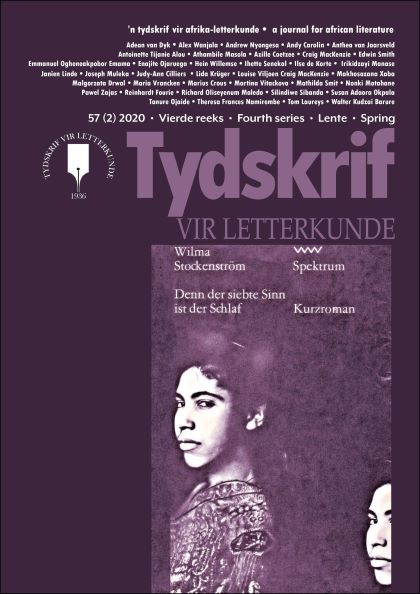Tradition and subjectivities: Warri-related comedians and their art
DOI:
https://doi.org/10.17159/tl.v57i2.8321Keywords:
tradition, subjectivities, performance, Warri, comediansAbstract
By some coincidence, many Nigerian stand-up comedians were born, raised, live in, or are associated with Warri and its environs. By Warri, as understood in the area, we mean Warri and its surroundings and, to a large extent, what is called the ‘core Delta’ of Nigeria’s Delta State. The comedians include Gordons, I Go Dye, AY and Real Warri Pikin. We investigate what is possibly responsible for the natural talent of these comedians. We relate the success of these comedians to the notion of Warri as ‘not coming last’, the history of the city of many ethnicities, boma boys, the blues nature of suffering pain and deprivations but laughing them off, and some indigenous traditions such as the Urhobo udje oral poetic performance which aims to elicit laughter as a means of maintaining normalcy and preventing anybody from deviating from the communally-established norms. We use multiple concepts such as laughter as a means of regulating people’s lives, satire, historicism, culture, and aesthetic considerations to study these Warri-related comedians and their art. We investigate the commonalities, subjectivities, traditions, and individual talents that have made Warri-born, raised, resident, and related comedians so successful—not only in Nigeria, but also in Africa and the world.
Downloads
References
Adejunmobi, Moradewun. “Stand-up Comedy and the Ethics of Popular Performance in Nigeria.” Popular Culture in Africa: The Episteme of the Everyday, edited by Stephanie Newell & Onookome Okome. Routledge, 2013, pp. 175–94.
AY. AY Live Asaba Full Show (Part 1). YouTube. https://www.youtube.com/watch?v=UGlXMbz72Sg.
AY. “Na So We See Am (A stage play).” YouTube. https://www.youtube.com/watch?v=unSXiWz__hA.
Bergson, Henri. Le Rire. P U de France, 2004.
Darah, Gabriel G. Battles of Songs: Udje Tradition of the Urhobo. Malthouse, 2005.
Dibie, Godfrey A. & Simon R. Odey. “Pidgin English and the attrition of indigenous languages in South-Southern Nigeria.” International Journal of Language, Literature and Culture vol. 5, no. 2, 2018, pp. 16–26. http://www.openscienceonline.com/journal/archive2?journalId=701&paperId=4571.
Donkor, David A. “Selling the President: Stand-up Comedy and the Politricks of Indirection in Ghana.” Theatre Survey vol. 54, no. 2, 2013, pp. 255–81.
Filani, Ibikun. “Discourse Types of Stand-up Comedy Performers: An Example of Nigerian Stand-up Comedy.” European Journal of Humour vol. 3, no. 1, 2015, pp. 41–60.
Filani, Ibikun. “The Use of Mimicry in Nigerian Stand-up Comedy.” Comedy Studies vol. 7, no. 1, 2016a, pp. 89–102.
Gordons. “Gordons Comedy Clinic Ward 6.” YouTube. 14 Jul. 2014. https://www.youtube.com/watch?v=M1NE60RfCIY.
Gordons. “I am still a Doctor of Comedy.” Channels Television. 14 Feb. 2015. https://www.channelstv.com/2015/02/14/still-doctor-comedy-clinic-gordons/.
Greenblatt, Stephen. “Murdering Peasants: Status, Genre, and the Representation of Rebellions.” Representations, no. 1, 1983, pp. 1–29.
I Go Dye. “AY Comedian: Me and My Top7 Comedians—I Go Dye.” YouTube. 26 Jun. 2013. https://www.youtube.com/watch?v=PM9wHMg1IqY.
I Go Dye. “I Go Dye Killing London with Laugh.” YouTube. 17 Mar. 2015. https://www.youtube.com/watch?v=ms46LesdukY.
Ndonye, Michael. M. F., Felicia Yieke & James O. Onyango. “Ethnicity as Discursive Construct in Kenyan Televised Comedy: Humorous Harm?” The Journal of Pan African Studies vol. 8, no. 3, 2015, pp. 44–60.
Nwosu, Maik. The Comic Imagination in Modern African Literature and Cinema: A Poetics of Laughter. Routledge, 2015.
Obadare, Ebenezer. “The Uses of Ridicule: Humour, ‘Infrapolitics’ and Civil Society in Nigeria.” African Affairs vol. 108, no. 431, 2009, pp. 241–61. DOI: https://doi.org/10.1093/afraf/adn086.
Ojaide, Tanure. Poetry, Performance, and Art: Udje Dance Songs of the Urhobo People. Carolina Academic, 2003.
Olaseni, Taiwo Olatunde. “From Jaguar to Ali Baba: humour in contemporary Nigeria.” Agogo: Journal of Humanities vol. 3, 2017, pp. 26–31. https://journals.oouagoiwoye.edu.ng/v2/index.php/AJH/article/view/99.
Onikoyi, Ayo. “20 Years as a Comedian: How My Grandma Showed Me the Path to Follow—I Go Dye.” Vanguard. 26 Mar. 2016. http://www.vanguardngr.com/2016/03/20-years-comedian-grandma-showed-path-follow-go-dye/.
Oribhabor, Edwin E “The Use of Naija in the Media, Arts and Entertainment.” Proceedings of the Conference on Nigerian Pidgin, 8–9 July 2009, U of Ibadan, Nigeria, pp. 1–8.
Real Warri Pikin. “Depression Pushed me into Comedy—Anita Asuoha (Real Warri Pikin).” Punch. 25 Aug. 2019. https://punchng.com/depression-pushed-me-into-comedy-anita-asuoha-real-warri-pikin/.
Real Warri Pikin. “Best of Real Warri Pikin: Funny & Motivational.” YouTube. 10 Sep. 2019. https://www.youtube.com/watch?v=HLlrPyXMQIw&feature=youtu.be.
Savage, Tiwa. “AY Comedian: Me and My Top7 Comedians—Tiwa Savage opens up about herself.” YouTube. 10 Sep. 2019. https://www.youtube.com/watch?v=-b3P5VEMMUs. Accessed 9 Sep. 2018.
Shipley, Jesse Weaver. “Comedies, Pastors, and the Miraculous Agency of Charisma in Ghana.” Cultural Anthropology vol. 24, no. 3, 2009, pp. 523–52.
White, Hayden. The Content of the Form: Narrative Discourse and Historical Representation. Johns Hopkins U P, 1987.
Downloads
Published
Issue
Section
License
Copyright (c) 2020 Tydskrif vir Letterkunde

This work is licensed under a Creative Commons Attribution-ShareAlike 4.0 International License.


 https://orcid.org/0000-0001-6465-6584
https://orcid.org/0000-0001-6465-6584


.png)